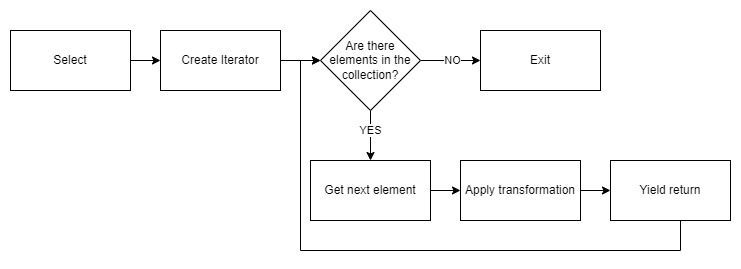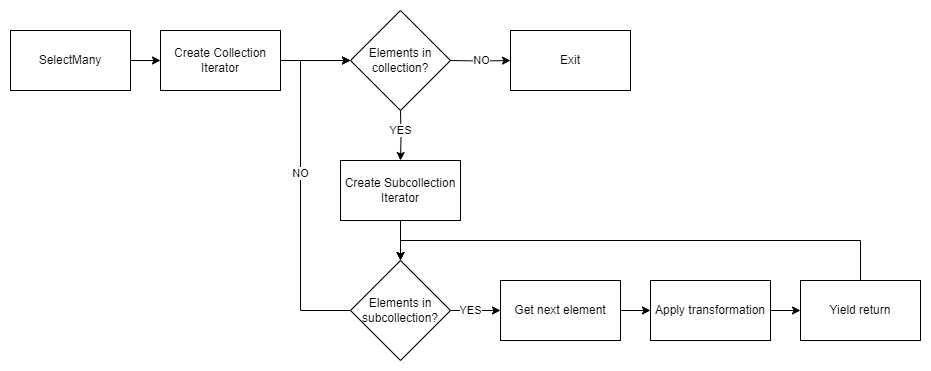In this article, we will uncover the Select and SelectMany methods in LINQ: essential tools for efficient data querying and collection management.
Let’s begin our exploration!
Understanding the Select Method
When we talk about LINQ (Language Integrated Query) in C#, the Select() method is one of the first tools that comes to our minds.
We can use one of the available overloads:
public static IEnumerable<TResult> Select<TSource,TResult> (this IEnumerable<TSource> source, Func<TSource,TResult> selector);
This extension method accepts the transformation function with just a single parameter, which is the element of our collection. This is the method that most of us C# developers use daily.
Alternatively, we can use the other overload:
public static IEnumerable<TResult> Select<TSource,TResult> (this IEnumerable<TSource> source, Func<TSource,int,TResult> selector);
This time, the method accepts the transformation function with two parameters.
The second parameter represents the index of the collection element. This might be useful in cases where we would like to engage the element index in the transformation function.
Both methods are a fundamental part of LINQ, enabling us to perform projections on our data.
Simplifying Data Projection
In the context of LINQ, projection refers to the transformation of each collection element into a new form.
This is what the Select() method does. It takes each element in a collection and applies a function to it, resulting in a new collection where each element is the transformed version of the original.
To visualize this, let’s consider an example:
var numbers = new List<int> { 1, 2, 3, 4, 5 };
var doubledNumbers = numbers.Select(num => num * 2);
Here, we use the lambda expression that describes how each element num in the numbers list should be transformed.
The result is a new doubledNumbers collection where each number is twice its original value.
Likewise, we can use the second overload:
var numbers = new List<int> { 1, 2, 3, 4, 5 };
var transformedNumbers = numbers.Select((num, index) => num * index);
As we can see, like in the previous example we use the Select() method to transform a collection of integers, but this time we multiply each element of the collection by its index.
In this case, the result is also a new transformedNumbers collection.
Understanding the SelectMany Method
Now that we know how to use the Select() method in LINQ, let’s turn our attention to another powerful tool in the LINQ arsenal: the SelectMany() method.
Like in the previous case, LINQ provides us with a few overloaded methods to choose from:
public static IEnumerable<TResult> SelectMany<TSource,TCollection,TResult> (this IEnumerable<TSource> source, Func<TSource,IEnumerable<TCollection>> collectionSelector, Func<TSource,TCollection,TResult> resultSelector);
This extension method accepts the collectionSelector function that transforms the collection and the resultSelector function that transforms each element of the flattened collection.
Alternatively, we can use the other overload:
public static IEnumerable<TResult> SelectMany<TSource,TCollection,TResult> (this IEnumerable<TSource> source, Func<TSource,int,IEnumerable<TCollection>> collectionSelector, Func<TSource,TCollection,TResult> resultSelector);
Similar to the case of the Select() method, we can also use an overloaded method that engages the index of the element in the collection.
Next is the overload that we can use to flatten the collection without transforming its elements:
public static IEnumerable<TResult> SelectMany<TSource,TResult> (this IEnumerable<TSource> source, Func<TSource,IEnumerable<TResult>> selector);
This time, the extension method accepts only a selector function that is used to flatten the collection.
Lastly, we have a counterpart of that overload:
public static IEnumerable<TResult> SelectMany<TSource,TResult> (this IEnumerable<TSource> source, Func<TSource,int,IEnumerable<TResult>> selector);
In this overload, we also have a selector function accepted as a parameter, but we add a second parameter that represents the index of the element.
Flattening Collections
To put it simply, the SelectMany() method is designed to streamline complex scenarios where we deal with collections of collections.
It does more than transform each element in a collection; it flattens multiple nested collections into a single, one-dimensional sequence.
This flattening aspect is what sets the SelectMany() method apart from the Select() method.
To better understand the SelectMany() method let’s define a list:
var listOfDepartments = new List<Department>
{
new Department
{
Name = "TechSupport",
Employees = new()
{
new Employee { Name = "Thomas", JobPosition = JobPosition.Admin },
new Employee { Name = "Cynthia", JobPosition = JobPosition.Admin }
}
},
new Department
{
Name = "Development",
Employees = new()
{
new Employee { Name = "Eric", JobPosition = JobPosition.Developer },
new Employee { Name = "Laura", JobPosition = JobPosition.Developer },
new Employee { Name = "Cedric", JobPosition = JobPosition.Developer }
}
},
new Department
{
Name = "BackOffice",
Employees = new()
{
new Employee { Name = "Monica", JobPosition = JobPosition.HumanResources }
}
}
};
Here, we have a list of instances of a Department class. The Department class contains a Name property representing the department name, and a list of Employee instances in a collection property named Employees.
Lastly, the Employee class contains Name and JobPosition properties that describe the employee.
Now, let’s see how we can use the SelectMany() method to flatten it:
var listOfEmployees = listOfDepartments.SelectMany(department => department.Employees);
Here, we use the SelectMany() method to extract Employee lists from each element of our listOfEmployees list and combine them into one list. After this operation, the listOfEmployees variable will contain a list of all of our employees.
Alternatively, we can use one of the overloads to enrich our employee details with department details:
var detailedListOfEmployees = _listOfDepartments.SelectMany(department => department.Employees,
(department, employee) => $"{employee.Name} | {department.Name} | {employee.JobPosition}")
First, we are flattening our collection of Department objects to a list of Employee objects.
After that, we modify each resulting element of that operation by transforming it into a string containing details from both Department and Employee objects.
Differences Between Select and SelectMany
Now that we know both Select() and SelectMany() methods in LINQ, it’s important to understand how they differ and when to use each. While they may seem similar at first glance, they serve distinct purposes and are best put to use in different scenarios.
Use Cases
First off, let’s consider when we should be using the Select() method and when the SelectMany() method.
The Select() method can be used to:
- Convert a list of one type to another type
- Get a specific property from objects in a collection
- Perform calculations, like in our example, where we doubled each number
On the other hand, the SelectMany() method is particularly useful in scenarios where we need to:
- Flatten nested collections or arrays
- Perform operations that involve combining or merging data from multiple collections
- Deal with hierarchical or relational data structures where elements are nested within other elements
As we can see, each of the methods has its unique purpose.
Structure of Resultant Collection
Another key point to note is the difference in the structure of the resultant collections.
The Select() method preserves the original collection’s structure by default. If we start with a collection of 10 elements, we end up with another collection of 10 elements, albeit transformed.
In contrast, the SelectMany() method changes the structure of the collection. It combines elements from nested collections, often resulting in a collection larger than the original, depending on the nested elements.
Internal Logic of the Select Method
Now, let’s have a look at an interesting way of working behind the scenes of the Select() method:
When we use the Select() method to project our collection into a new form, it doesn’t execute right away.
What it does is create an IEnumerable instance that holds all the details about the operation we want to perform. This is what we call deferred execution.
Now, when we start going through this IEnumerable, it steps in with the iterator pattern. This pattern lets it process each element one by one, using the yield return statement.
Each element goes through the transformation defined by a lambda expression that we give to the Select() method. This expression conveys what should be done with each element.
Internal Logic of the SelectMany Method
With all this in mind, now let’s have a look at what logic is applied to the SelectMany() method:
Just like its cousin the Select() method, the SelectMany() method embraces deferred execution and the iterator pattern.
As its iterator goes to work, it processes every element in the source collection, using a lambda expression we provide.
For every single item in our source collection, the SelectMany() method doesn’t stop at iterating over the IEnumerable provided by our lambda. It picks out each element in turn from these nested collections using yield return.
This clever maneuver is what gives us our single, neatly flattened sequence.
Best Practices and Performance Considerations
It’s crucial to recognize that effectively using LINQs Select() and SelectMany() methods involve more than just understanding their functions.
Applying best practices and comprehending their impact on performance is essential for crafting efficient and well-maintained code.
Efficient Use of Select and SelectMany
Both Select() and SelectMany() methods can introduce overhead, especially when dealing with large collections.
Because of that, we should minimize the number of transformations and flattening operations. If possible, we should combine multiple transformations into a single Select() or SelectMany() call.
We need to remember that LINQ queries are not executed until we iterate over them. This can be both an advantage for efficiency and a source of confusion if not managed properly.
Because of that, we should plan when our data is queried and transformed.
While deferred execution can improve performance by not processing data until necessary, it can also lead to unexpected performance hits if the same query is iterated multiple times.
For that reason, we need to consider caching results if we want to reuse them.
Performance Considerations
Another thing to consider is the performance overhead of both methods.
The Select() method is generally efficient, but performance can degrade if the transformation function is complex or if it’s used on very large collections.
In general, the SelectMany() method can be more resource-intensive in comparison to the Select() method. Especially with large and deeply nested collections.
It can significantly increase the number of elements in the resulting collection, which may impact memory usage and processing time.
While it’s important to be aware of these performance considerations, we should avoid focusing too intently on performance optimization from the start as it can lead to complex, hard-to-read code.
To cope with that, we should always write clear, readable code first, then optimize based on profiling and actual performance needs.
Conclusion
In this article, we delved into LINQs Select and SelectMany methods in C#, exploring their distinct functionalities, use cases, and key differences.
While the Select method is ideal for simple transformations of collection elements, the SelectMany method excels in flattening nested collections, making it invaluable for more complex data structures.
By understanding the Select and SelectMany methods and adhering to best practices for efficiency and performance, developers can effectively harness the power of LINQ to write more efficient, readable, and maintainable C# code.






